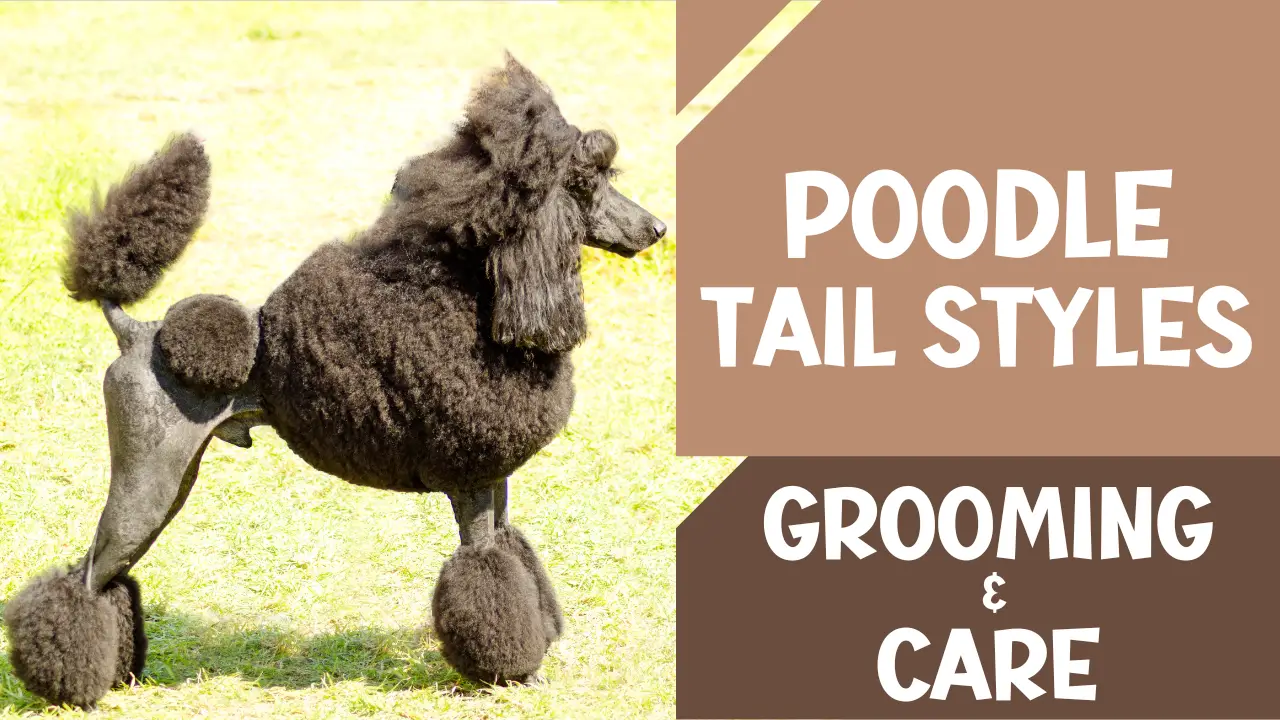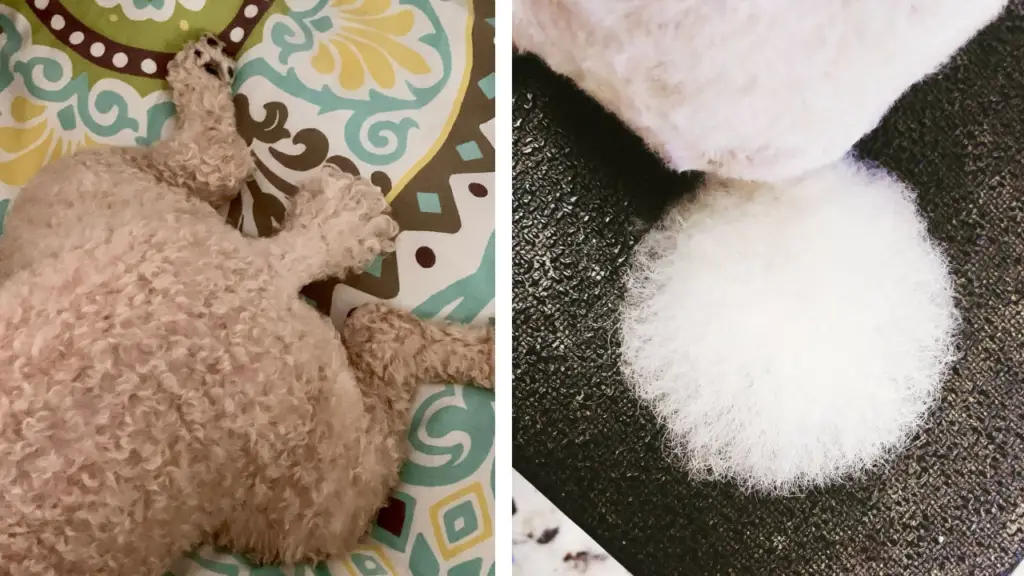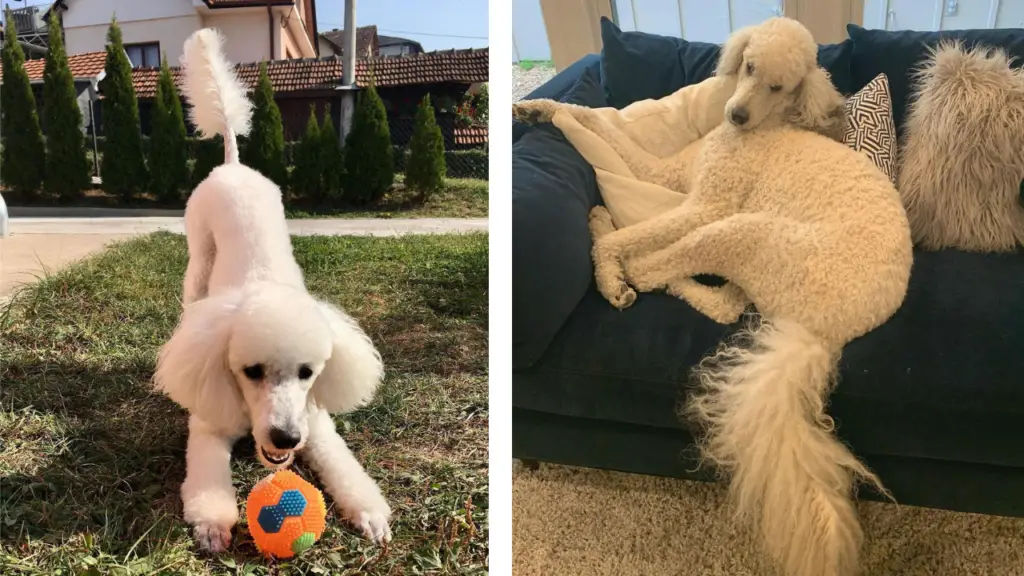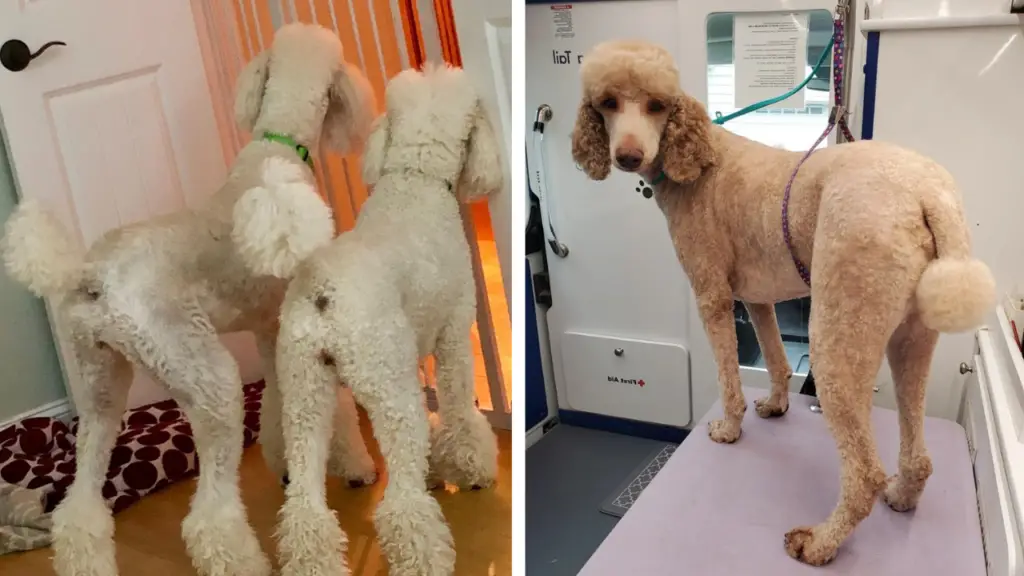If you own a Poodle or are planning to own one, then there are a few types of tail styles you can have for your Poodle. While there are a few that exist, there are three styles that are highly popular:

What Will You Learn? 👇
Docked
One common type of tail many Poodle breeders and owners choose is docked. This is a traditional practice that’s been long used in the show world; however, it faces some criticism as many view it as just cosmetic and inappropriate. It’s believed tail stocking stemmed from Roman times, thinking it reduced the likelihood of a Poodle getting rabies and that they were better hunters.

However, no evidence exists to support this strongly. With Poodles being water retriever dogs, it’s also thought their tails were docked to help enhance their swimming and hunting abilities.

Read our Smart Poodles - Smart Tricks eBook for only $2.99
Dive into a treasure trove of engaging tricks and tips designed specifically for your poodle!
The procedure
Normally when Poodles have their tails docked, it usually happens between 3-5 days old, and they have a week of recovery time. Many people do this in this time frame because it’s thought the Poodles nervous system hasn’t fully developed by this point, so they won’t be able to feel a lot of pain. However, many experts don’t believe this theory.
The surgery involves no general anesthetic and involves using scissors on the tail to remove the tail. Once surgical scissors cut the tail off, it’s believed that the other end will not receive sufficient blood flow, causing the tail tip to fall off within a few days. Usually, licensed veterinarians perform it, but breeders can do it, also.
Pros
I just want to reemphasize that tail docking is a controversial topic, so there are not many benefits. Some of the pros of tail docking are:
- Can help with hygiene: Docking a Poodle’s tail can make cleaning slightly easier. That’s because feces, dirt, and debris are less likely to build up on the tail reducing the risk of infection.
- Aesthetics: Some breed standards for shows require certain looks, and tail docking may meet that standard to achieve a specific appearance.
- Reduce the risk of tail damage: Sometimes, medical conditions make Poodles more likely to get injuries or damage their tails. Sometimes tail docking is recommended to stop this in such cases.
Cons
When it comes to tail docking Poodles, they have several negative consequences. Some of the main ones are:
- Pain: Tail docking can be incredibly painful for a Poodle as it’s done without any anesthesia. Similarly, the healing process can cause a lot of discomfort, taking up to several weeks to heal.
- Difficult to communicate: One major communication method Poodles use alongside other dogs is their tail. If their tail is docked, their ability to communicate can be limited. As a result, expressing their emotions like aggression, excitement, or anything else can be extremely difficult, which can lead them to be misunderstood.
- Health complications: This procedure has a lot of complications associated with it, like infection, bleeding, damage to the surrounding tissue, and more. These complications can increase the chances of your Poodle experiencing further pain and discomfort. There is a risk of them needing more medical treatment.
- May affect their balance: The tail is an important part of a Poodle’s coordination and balance. If you dock their tail, their balance may be impaired.
- Ethical issues: As tail docking is such a controversial topic, it may cause some ethical issues. Many countries have completely banned the practice or restricted it based on specific circumstances.
Natural
Often there are so many types of Poodle tails out there that we forget about the natural ones. A natural tail can range from 8-10 inches long and covered in a lot of fur. Sometimes the tail can have a small curve to it and be a bit wild. It’s less polished than a typical tail.

Pros
- Communication: A natural tail allows a Poodle to communicate freely.
- Balance: They can make quick movements and stay balanced.
- Expression: A natural tail allows them to express themselves freely
- Appearance: Many dog owners think a natural tail is much more attractive and keep the Poodle looking more elegant.
- Helps with sports: Natural tails can help with their agility and balance and make them swim or have a better active lifestyle.
Cons
- More difficult to groom: With a natural tail being longer and having more fur, it takes more time to groom, getting mats, tangles, dirt, and debris out.
- Damage to household items: A natural tail is slightly longer, which means they could knock over household items at home by accident.
Custom
A custom tail for a Poodle is a tail that’s not the standard for the Poodle. A Poodle can have various custom styles, all based on your preference. Some of the most common styles for a Poodle are:

- Teddy bear: This is where the hair is slightly longer than a natural tail fluffing out at the ends like a teddy bear.
- Topknot: This tail has a ribbon or bows at the top, tying the top of the tail into a knot.
- Lion tail: Hair is kept long at the base, and the rest is trimmed short.
- Pom-pom: This hair involves being trimmed into a round shape like a pom-pom.
Pros
- Different appearance: A custom tail can make your Poodle stand out, making it look unique.
- Creativity: If you like attention, a custom tail can be a great way to show off your creative skills and Poodle’s personality.
- Maintenance: Some custom styles, like the teddy bear and pom pom require less maintenance than a natural tail. You might not need to brush them as frequently.
- Competitive advantage: If you are entering your Poodle in a dog show, a custom tail can help your Poodle stand out and give you the upper advantage over a traditional look.
Cons
- Grooming Requirements: Depending on the type of custom tail you choose for your Poodle, more grooming requirements may be involved. It may take much more time to upkeep and require a professional groomer.
- Discomfort: Some custom tails may cause the Poodle discomfort or irritation.
- Likelihood of injury: There are some custom tails, like the lion tail, which can make them more prone to injury or irritation.
Factors to Consider When Choosing a Tail Style
Before you choose a tail style for your Poodle, you should pay careful consideration to the following factors:
- Dog’s personality
Tails are a major communicator Poodles use to signify their happiness, playfulness, aggression, fear, and more. Before deciding on the right tail you want for your Poodle, you should think about their typical moods and get a tail that reflects their mood and supports their communication.
- Dog’s lifestyle
If your Poodle is active and tends to jump and run a lot, it will need a shorter or natural tail. There is a risk if their tail is too long, it can get injured or caught on something.
- Dog’s breed standards
Before selecting a tail, consider the breed standard for a Poodle. This is especially important if you’re entering your Poodle in a show.
- Personal preferences
At the end of the day, it’s your Poodle! So you must consider what you like, what’s, and what’s comfortable for your dog. What you might like may be different from another Poodle owner.
Maintenance and Care for Different Tail Styles
Brushing and trimming
- Docked tail: To brush a docked tail, you should stick to using a soft-bristled brush. Always start at the base and move towards the tip. This will help remove any mats and tangles. You should also use a mat comb to remove any mats from their tail.
When trimming, use scissors to trim hair that’s uneven or too long. Always hold the scissors at a slight angle when cutting, and make sure you don’t cut the skin.
- Natural tail: You should use a slicker brush to remove dirt and debris when brushing a natural tail.
- Custom tail: Speak to a professional groomer about brushing and trimming a custom tail. Due to the complexities this tail involves, you might want to get them to do it.
Cleaning and hygiene
- Docked tail: Use a damp cloth to clean your Poodle’s tail, and pay extra attention to any areas that may have odor or dirt.
- Natural tail: Use a pet wipe or damp cloth to clean the tail.
- Custom tail: Speak to your local groomer on how to clean a custom tail, as there are many that are different and change accordingly.
Health and safety concerns
- Docked tail: Always inspect the tail for any injuries, swelling, redness, or bleeding. If you see any of these, contact your local veterinarian for advice.
- Natural tail: Check the tail to see if there are any mats or tangles and if there are no feces stuck or dirt in the tail.
- Custom tail: A custom tail’s health and safety concerns can vary based on the design. To better understand, you should speak to a vet or groomer.
FAQ
Can poodles with natural tails participate in dog shows?
Poodles with natural tails can easily participate in dog shows; however, I recommend you check the rules and regulations of the show first. For instance, the American Kennel Club and other clubs require tails to be docked for conformation shows in the USA. Whereas with other organizations, Poodles that have natural tails can compete. So always check the show guidelines first!
Marko is the founder and author at PoodleHQ, where he blends profound expertise with formal training in Animal Behavior and Canine Genetics. With multiple generations of poodles under his care, he’s a breed connoisseur, honored with the Canine Care Excellence Award and lauded by the International Pet Enthusiasts Association.

